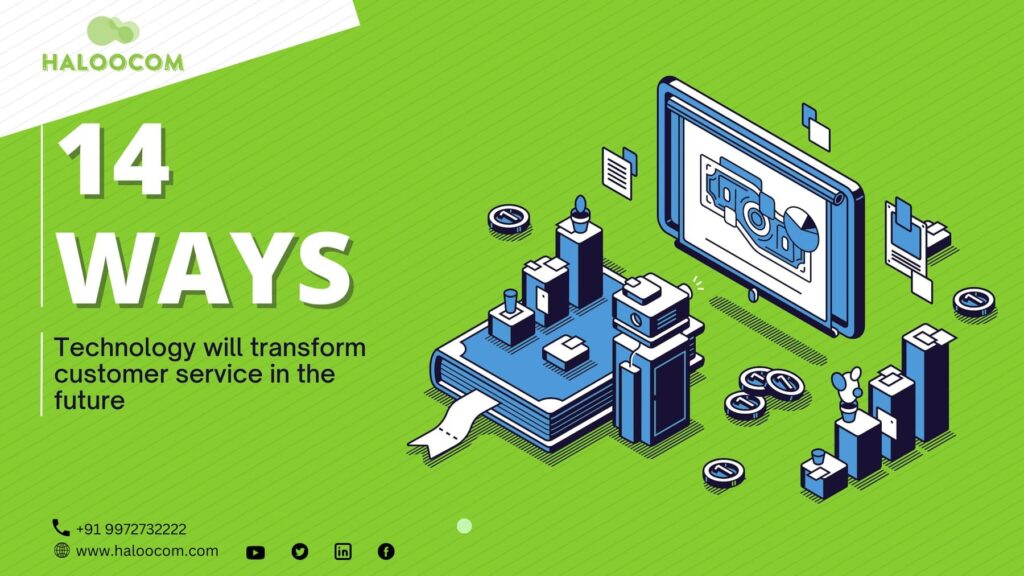The emergence of new technologies in customer service, support, and success has generated a lot of buzz. With advancements in video, real-time messaging, chatbots, AI, cryptocurrencies, self-service, and even the concept of customer success, significant changes are on the horizon for those working in this field.
Despite the benefits, new technology also brings about its own set of challenges. The adoption of new technologies can be difficult and expensive for businesses, and the fear of the unknown can be daunting.
How technology going to shape the future of customer service?
1- Face-to-face video communication will increase
As customers increasingly seek more personal and engaging interactions, non-video, real-time voice conversations are becoming outdated. Companies that use video technology, such as video voicemail or video conferencing, are ahead of the curve in meeting these expectations. Eye contact, a powerful communication tool that fosters relationships and openness, is facilitated by video interactions. Implementing video voicemails and scheduling face-to-face meetings whenever possible can enhance customer relationships and ultimately benefit business outcomes.
2- Customers will expect an omni-channel service experience.
In the digital age, customers interact with businesses through multiple channels like social media, ecommerce, and review sites. To meet the growing demand for accessibility, businesses must provide an omni-channel service experience that seamlessly syncs communication channels. This eliminates the need for customers to navigate between interfaces, reducing friction in the service experience.
A central inbox, such as a help desk, is essential for agents to communicate with customers across all channels. This ensures that agents use the same interface to communicate with customers, no matter where the interaction starts online.
With omni-channel support, customers don’t have to navigate away from your social media page or ecommerce platform. Your service team can respond to them wherever they’re engaging with your business. If a problem can’t be solved on one communication channel, agents can easily transfer the case to another medium where they can better support the customer.
3- Real-time messaging will outpace email.
Customers prefer chat over phone or email and expect real-time messaging and responsiveness from businesses. Facebook Messenger has set the bar high with its real-time support and average responsiveness indicator. This expectation extends beyond social media channels to on-site conversations and chat.
Businesses need to adapt to this synchronous communication trend and invest in technologies and strategies that allow for seamless, real-time, and authentic conversations with customers. However, email remains a critical tool for sharing important documents and communications.
To meet these demands, businesses can use shared inbox tools like HubSpot to collect and assign incoming messages from customers across multiple channels in one place. This way, businesses can offer an omni-channel experience and provide real-time support to customers while still using email for important communications.
4- Remote work will become more normal.
In the future of customer service, service reps will not be limited to working in call centers or offices. They will have the ability to work remotely using various tools to field customer inquiries. Email, live chat, and social media can already be operated on smartphones and most business phone services offer cloud-based solutions that allow working from home. As businesses start to realize the benefits of reducing office space, working remotely will become more common for service reps.
5- Bots (and AI) will help professionals, not replace them.
Certainly, bots have been gaining popularity in customer service, but it’s too soon to say whether they will completely replace human agents.
Bots – the future robotic overlords, or maybe not? In reality, most bots aren’t actually using any form of artificial intelligence, but rather rely on a conversational user interface with branched logic. Conversational UI is an excellent way for businesses to stay on the bleeding edge of innovation and engage with customers. However, while bots backed by good tech can be clever, it’s not “artificial intelligence.”
For customer-facing teams, the near-term opportunity with bots is twofold: bots can provide customer service while teams are unavailable and improve self-service for customers while reducing expenses for vendors. Over the next 10-25 years, this technology will continue to advance, enabling bots to perform tasks humans do today. Thus, it will be important for customer-facing teams to keep up with bot progress and stay on the cutting edge to provide increasingly better experiences at increasingly lower costs.
In the future, bots and AI will be a game-changer for customer support, where reps spend close to 90% of their time on the job answering the same questions repeatedly. Machines can learn, train, and teach, too, so human reps will only have to deal with edge cases where bots cannot answer questions with the help of a knowledge base or a past history of customer questions.
As bots and AI become mainstream, leaders can reallocate customer support reps into customer success organizations. There will be less need for repetitive answering of questions and a greater need for helping customers grow and derive value from the products and services they’ve purchased. In the grand scheme of things, customer support is about engaging with customers reactively, customer service is about guiding them with new suggestions and added value, and customer success is about helping customers grow and can provide infinite additional value for both the customer and the company.
6- Blockchain will change e-commerce customer support.
Cryptocurrency may not bring significant changes to customer success, as paying with bitcoin is similar to other currencies in the post-sale process. However, blockchain technology has the potential to revolutionize contracting and increase payment transparency in the future. Smart contracts, which allow machines to execute and enforce contract terms and payments without human intervention, are more advanced than traditional recurring payment models.
Smart contracts could lead to a future where customer success managers (CSMs) spend less time dealing with payment issues and more time providing value to customers. While a shift from USD to BTC may not become mainstream and won’t have a major impact on the industry, blockchain technology could transform commerce within the next 25 years, potentially altering the role of CSMs as commercially-involved parties.
7- Self-service will become an absolute necessity.
Self-service has been around since the first user manual was written. However, with the rise of bots and AI, new opportunities for self-service have emerged.
Customers and users are changing quickly, and they now expect more self-service options than ever before. Businesses are providing various self-service tools to their customers, as seen in the chart below.
Why is this change happening? Most vendors that customers interact with today are large and technologically advanced. These businesses embrace self-service because it reduces their operating costs, and it enables them to push the envelope on more sophisticated methods of customer interaction.
Businesses that fail to keep up with this change risk looking outdated to their customers. In a world where messenger bots and location-aware mobile apps are the primary means of interaction, businesses that don’t offer self-service channels will seem antiquated. Phone and email, like snail mail, may soon be obsolete.
The first step in helping your customers help themselves is to create a knowledge base where you can provide answers to common questions. By doing this, customers can find the information they need on Google or through voice search devices, without needing support from your customer service reps.
8- Customer service training will be personalized.
In the past, customer service training has been a one-size-fits-all approach. However, with the advent of sentiment analysis tools, it is becoming easier to identify the strengths and weaknesses of each representative, making training more personalized and effective.
This means that representatives who require more time to learn the product can focus on mastering its features, while those who are more technically proficient can receive training to improve their soft communication skills.
To implement personalized training, it is essential to survey your team before, during, and after each training session to measure their performance and gather feedback. This not only builds trust with new representatives but also creates a customized onboarding process for each agent
9- Customer success will become a competitive differentiator.
In the next five years, excellent customer success will become as crucial for businesses as excellent customer support is today. The fast and efficient progress of companies searching for customer value has made the customer success industry too significant to ignore. The concept of customer success is spreading beyond just the software-as-a-service industry and growing quickly. When customer success becomes a standard requirement, just like customer support, it will be an exciting time to witness the takeover. However, it will pose a challenge for companies aiming to expand their customer base. Successful businesses with happier customers will raise the bar higher for new entrants, and customer success will become imperative from day one, increasing startup costs and reducing margins for new entrants. If you’re already implementing customer success at your company, you’re ahead of the game.
10- Customer service decisions will be more data-driven.
To evaluate the effectiveness of any service technology, it is essential to have a way to quantitatively measure its success. This will become even more important as companies increasingly adopt service technology, making their customer service teams reliant on analysing the success of these programs.
By using service technology, customer service departments can access valuable data about customer interactions. This data can help identify customer needs and roadblocks, enabling customer support and success teams to improve the overall customer experience. Marketing and sales teams can also benefit from this data by using it to enhance their initiatives.
Marketing teams can use this data to identify new roadblocks and update the customer journey map, while sales teams can use it to understand relevant customer needs and tailor their sales pitch. Adopting service technology will increase demand for customer service data, which can benefit the entire organization.
11- Social Media will become a standard customer service tool.
Social media has given consumers a platform to publicly criticize brands and share their negative experiences, which can quickly go viral and damage a company’s reputation. With the majority of consumers trusting peer opinions, businesses need to have a consistent and effective response plan to handle negative feedback. This requires adapting social media accounts to handle customer service interactions, whether through messaging or dedicated representatives. Previously, social media channels were not considered viable customer service options, but as more customers turn to these platforms to provide feedback, companies must engage with them on their own turf to maintain their reputation.
12- New technology will create new customer service positions.
New technology will create opportunities for new customer service roles. For instance, augmented reality will enable virtual assistants to assist customers in learning how to use products and services. Customers will have the ability to simulate a product and receive digital support as they become familiar with its features.
Specialization will also become important as more customer service channels emerge. Representatives will need to have specialized skills and knowledge to provide effective support. This will result in reps focusing on specific channels to learn all the nuances needed to succeed.
Potential roles we can anticipate include chat specialists, social media specialists, and onboarding specialists.
13- Customer service representatives will solve fewer problems.
As more AI and self-service options are introduced, there will likely be a decline in the number of cases handled by customer support teams. This is because customers will be able to resolve smaller and simpler issues on their own or with the help of these resources.
However, this doesn’t mean that companies should eliminate their customer support teams altogether. In fact, with fewer cases to handle, customer support representatives will have more time to focus on more complex and challenging problems. This leads to a better customer experience because reps can offer a more personalized and thorough interaction.
In addition, as front-line customer service handles more cases, product experts such as engineers and product developers can spend more time improving the product or service instead of being bogged down with customer-facing responsibilities. This allows for more innovation and better overall offerings for customers.
14- The frontline service representatives will be more flexible and empathetic.
Upcoming technology will equip customer service representatives with the necessary resources to excel in their jobs, freeing up their time from worrying about mundane procedures and enabling them to concentrate on their clients’ requirements. This will make customer service professionals more adaptable and compassionate, as they will experience fewer obstructions in their work processes, prompting them to deliver exceptional customer service.
Haloocom is adopting new technology to enhance its customer service capabilities, particularly in the realm of chat support. By implementing advanced chat technology, Haloocom can provide quick and efficient responses to customer inquiries, while also freeing up customer service reps to handle more complex issues. This technology also allows Haloocom to gather valuable data on customer interactions, which can be used to continually improve and personalize the customer experience. Overall, Haloocom is committed to leveraging technology to provide exceptional support to its customers.






